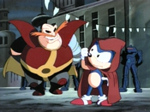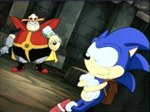
Editorial: Why Robotnik is a Great Villain
6/07 - Written by Rookie Reaves The "SatAM" Sonic the Hedgehog series' portrayal of Dr. Ivo Robotnik (Eggman in the various video games) was a radical change from the incompetent and comical baddie from the "Adventures of Sonic the Hedgehog" program and provided a much more elaborate design than his gaming counterpart. As opposed to the Teddy Roosevelt look-alike from the games, this "Buttnik" (as Sonic would call him) was a much more menacing character. He was given cybernetic eyes and a robotic left arm. Most notably, he was voiced with chilling efficiency by voice acting legend Jim Cummings.
The "SatAM" Sonic the Hedgehog series' portrayal of Dr. Ivo Robotnik (Eggman in the various video games) was a radical change from the incompetent and comical baddie from the "Adventures of Sonic the Hedgehog" program and provided a much more elaborate design than his gaming counterpart. As opposed to the Teddy Roosevelt look-alike from the games, this "Buttnik" (as Sonic would call him) was a much more menacing character. He was given cybernetic eyes and a robotic left arm. Most notably, he was voiced with chilling efficiency by voice acting legend Jim Cummings.
Throughout the first season, Robotnik's voice was aided by a cold, metallic echo that no doubt would have made Darth Vader proud. Everything was in place to make this character a truly effective villain, but there was one problem: for much of the series' run, Robotnik was a thoroughly one-dimensional baddie who's goals beyond maintaining and expanding his empire on the planet Mobius were never made clear, at least during season one. Truth be told, the character could easily have gone down as a completely cliched bad guy not worthy of revisiting, but, surprisingly, he remains memorable to this day. How so?
For one thing, the contribution of Jim Cummings to the character cannot be overstated. The "SatAM" follow-up, "Sonic Underground", featured a version of Robotnik consistent with the Cummings character design, but falls flat in comparison. Actor Gary Chalk, who had previously voiced Grounder (one of Robotnik's henchmen) in the "Adventures of Sonic the Hedgehog" program, simply didn't convey the same aura of evil that Cummings had. "SatAM" began with a fairly dark tone, and Cummings offered a fitting and sinister performance to match. It's a testament to his talent that he has been so versatile with his work.
Secondly, one aspect of the character that set "SatAM" Robotnik apart from other cartoon villains was the fact that rather than simply pursue the age-old movie serial goal of world domination, he enjoyed that very luxury during the entire series' run. One particularly noteworthy line of his from the episode "Sonic Past Cool" sums up his dominance:
"These terrapod beasts are the final species to be roboticized. When they're done, I will control every living thing on this planet."
Perhaps in the tradition of "Star Wars", he was a power-mad dictator attempting to keep his empire intact in the face of increasingly damaging attacks by a small group of rebels. In short, he was a villain with the upper hand.
The dark capital city of Robotropolis practically captured the character's very essence, as did his haunting first season theme. That particular musical piece, reminiscent of the main "Scarface" theme from 1983, summed up Robotnik's tyrannical nature in an epic way rarely heard on public television, much less a Saturday morning cartoon. In fact, if Robotropolis was a hellish nightmare world, Robotnik was the devil himself. Indeed, his red uniform and pupils, coupled with his pointed shoulder pads seemed to evoke western satanic imagery. It's actually not too difficult to compare Robotnik to the devil given his deceitful and manipulative nature. Throughout the series he is shown misleading, lying to, and outright backstabbing practically everyone that he knows and encounters, blatantly displaying his lack of loyalty to anyone but himself. His is wicked to the very core, not only usurping the King's throne, enslaving the population and betraying his own allies, but is also (according to the episode "Sub Sonic") guilty of mass murder. As one character puts it, "evil he is, pure evil."
 Furthermore, the most interesting villains serve as mirror, albeit more evil images of the heroes. Sonic is a flawed hero at best whose arrogance and tendency to rush into things occasionally place him in jeopardy. Similarly, Robotnik's overconfidence in himself unintentionally provides the Freedom Fighters with the means to thwart him. It's also interesting to note that both the hero and the villain have allies that try to prevent their egos from destroying them. Sonic has Princess Sally, who repeatedly warns him about his impatience and bloated ego; on the other hand, Robotnik has his nephew Snively, who logically advises his uncle to separate his pursuit of his arch enemy with the running of his kingdom and even goes so far as to predict Robotnik's downfall, just as Sally often predicts the consequences of Sonic's actions. The difference is that Robotnik and Snively's relationship is built on natural hatred whereas Sonic and Sally's is based on love.
Furthermore, the most interesting villains serve as mirror, albeit more evil images of the heroes. Sonic is a flawed hero at best whose arrogance and tendency to rush into things occasionally place him in jeopardy. Similarly, Robotnik's overconfidence in himself unintentionally provides the Freedom Fighters with the means to thwart him. It's also interesting to note that both the hero and the villain have allies that try to prevent their egos from destroying them. Sonic has Princess Sally, who repeatedly warns him about his impatience and bloated ego; on the other hand, Robotnik has his nephew Snively, who logically advises his uncle to separate his pursuit of his arch enemy with the running of his kingdom and even goes so far as to predict Robotnik's downfall, just as Sally often predicts the consequences of Sonic's actions. The difference is that Robotnik and Snively's relationship is built on natural hatred whereas Sonic and Sally's is based on love. In addition, it's also worth noting that the intense rivalry that the hero and villain share is marked by a mutual "need" for one another. At the end of "Sonic's Nightmare", for example, Robotnik, who seems to have the upper hand over his opponent, hesitates to push the button that would seal his enemy's doom, and is barely able to contain himself. In "Game Guy", he again has the hedgehog cornered, but rather than immediately "squash him" as Snively wisely suggests, Robotnik insists on torturing him, claiming that he wants to "savor it." Finally, in "The Doomsday Project", the cackling villain, having trapped Sonic once again, admits that he's "almost sorry that it's over" and credits him with being a "most worthy adversary." And once Robotnik has been overthrown by the end of the episode, Sonic responds to his defeat with an unexpected "Too bad" to a surprised Sally. "Without a villain, what are heroes gonna do?" he complains lightheartedly. It's an interesting dynamic to afford the hero and villain of the story with such a relationship that at least partially binds their existence, and in a way, makes them two sides of the same coin, one good, the other evil. Does Sonic's supposed "disappointment" at Robotnik's vanquishing represent an inconsistency with the fight for freedom? Not at all. Rather, it befits the adventure-craving aspect of his character. At the same time, Sonic represents Robotnik's obsession, and it's not enough that the dictator rids himself of the hedgehog, he wants, arguably needs him to suffer in order to feel satisfied.
 Finally, there is the important issue of the villain's motive. A bad guy benefits from having an adequate and believable reason to destroy the hero, rather than the fact that his evil plans are always being ruined. Fortunately, the epic two-parter, "Blast to the Past", provides Robotnik with a more than reasonable motive to hate Sonic by making the blue rodent responsible for the robotization of his left arm, thus creating an Ahab-Moby Dick dynamic. With knowledge of how Robotnik's obsession with both torturing and destroying the hedgehog started, the audience can now watch as the obsession destroys both him and his empire by the series' end. While this doesn't necessarily humanize Robotnik and certainly doesn't make him a three-dimensional character, it creates a more deep-seated psychological edge. With "Blast to the Past", Robotnik's personal hatred for Sonic becomes more interesting and adds weight to episodes in which Robotnik jeopardizes all of his other objectives in pursuit of one particular enemy. That, added with Jim Cummings' memorable portrayal of evil, deceit, and rage succeeded in creating a truly memorable villain, certainly moreso than he could have been.
Finally, there is the important issue of the villain's motive. A bad guy benefits from having an adequate and believable reason to destroy the hero, rather than the fact that his evil plans are always being ruined. Fortunately, the epic two-parter, "Blast to the Past", provides Robotnik with a more than reasonable motive to hate Sonic by making the blue rodent responsible for the robotization of his left arm, thus creating an Ahab-Moby Dick dynamic. With knowledge of how Robotnik's obsession with both torturing and destroying the hedgehog started, the audience can now watch as the obsession destroys both him and his empire by the series' end. While this doesn't necessarily humanize Robotnik and certainly doesn't make him a three-dimensional character, it creates a more deep-seated psychological edge. With "Blast to the Past", Robotnik's personal hatred for Sonic becomes more interesting and adds weight to episodes in which Robotnik jeopardizes all of his other objectives in pursuit of one particular enemy. That, added with Jim Cummings' memorable portrayal of evil, deceit, and rage succeeded in creating a truly memorable villain, certainly moreso than he could have been.



